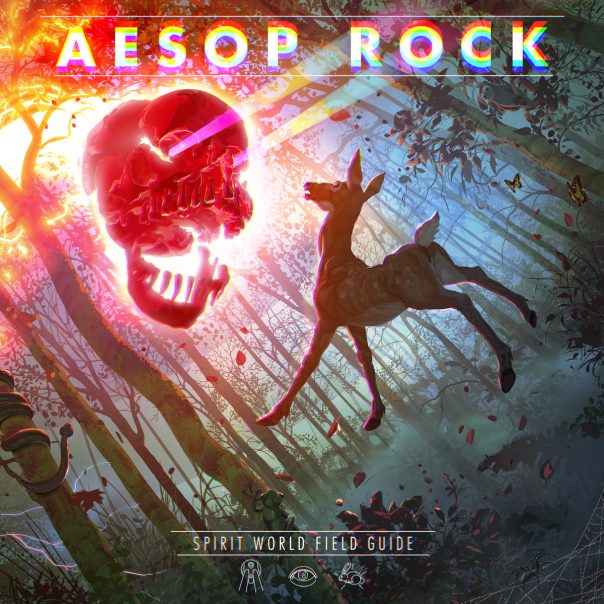ALBUM REVIEW: Aesop Rock leads us through his ‘Spirit World Field Guide’

Ever-elusive underground hip-hop recluse Aesop Rock has returned from the ethereal depths of his recent journeys to deliver his Spirit World Field Guide. Known for his complex and verbose prose informed by his neurotic disposition, Aesop Rock’s newest album follows critically acclaimed 2016’s The Impossible Kid.
Spirit World Field Guide
Aesop Rock
Rhymesayers, Nov. 13
8/10
Since then he’s collaborated with an array of creative personalities, such as on 2019’s Malibu Ken—a collaborative album with electronic artist Tobacco—as well as scoring the soundtrack to the 2017 film “Bushwick” and working on the soundtrack to 2019 video game “Freedom Finger.”
As the title suggests, Spirit World Field Guide is a guide to navigating the spiritual elements that make up our world—albeit with a healthy dose of Aesop Rock’s signature anecdotes on existentialism, isolation, anxiety, death and esoteric—if sometimes kitsch—subjects. As with his last three releases, the album continues on with a more easily accessible lyrical style, but proves at times to be some of Aesop Rock’s most dense writing to date.
Opener “Hello From The Spirit World” delivers a spoken word intro over some easy marimba and soft bass backing. It’s a preface and a sort of table of contents to help us navigate the album. There are recipes, survival tips and guidelines to help you on your way.
“The Gates” transitions to the start of Aesop Rock’s journey among the supernatural, carried by an 8-bit melody and bass backing synths. It’s a metaphor for Aesop’s continuous struggle to adapt to society—opting to abandon it in favor of another reality. “I don’t pussyfoot, I make potholes, my path home is all drop zones/ Flash bulbs and strobe lights, road signs with crossbones,” he raps.
“Button Masher” uses some sparse electric guitar chords over a synthetic hum and a driving bass line as Aesop Rock raps about traversing the spirit world through an otherworldly vessel. It’s likely a stand-in to describe his barn home in rural Oregon. The chorus is broken up with a call and response between guitar riffs and Aesop chanting with a piano breakdown later in the song, transitioning to a moment of reflection on his past.
“Dog At The Door” is one of the more peculiar tracks here. It’s told from the perspective of a paranoid family dog on watch at the front door after hearing some stirring noises. The narrative quality is highly reminiscent of “Ruby 81” off of Skelethon. This isn’t the first time Aesop Rock has told a story about a dog.
“Pizza Alley” strips things down with a series of plunking xylophone tones and a crescendoing synth. Aesop raps about his eye-opening and surreal experiences while traveling in Peru: “Talk rap albums over alpaca medallions/ With metalhead who traffic magic flowers from the mountains.” The subsequent beat switch-up halfway through has heavy-hitting reverb-laden percussion and thick bass line to further emphasize a deep contrast of the natural regions of Peru and the bustling city life.
“Jumping Coffin” kicks off with some tight scratching segueing into a synthetic beeping melody and pronounced snares. On this track, Aesop Rock opens up on his struggles connecting with people and maintaining those connections, while recognizing the need for him to let others in. “Holy Waterfall” delivers an eerie quality with fuzzy synths and funky bass line. Aesop reflects on his success as a rapper as he elaborates with some impressive use of imagery.
“Kodokushi” has Aesop Rock exploring the afterlife as an angry ghost. The name is a reference to a Japanese phenomenon where someone is found dead alone in his home weeks after dying because of limited connections to the outside world. It’s a concept that’s similarly referenced on”Dorks,” from The Impossible Kid. The frantic scratching and high-hats on “Kodokushi” elevate the anxious quality of the subject matter.
On “Sidequest,” Aesop talks about going skateboarding late at night to a store, only to get sidetracked as he continues to aimlessly navigate city streets. The bass line and drums carry a steady beat, only to be chopped up in time with Aesop’s fragmented rapping. Closing track “The Four Winds” finds him returning to our world, feeling further disconnected from the people around him as a result of what he’s learned in the spirit world.
Aesop Rock continues to display his prowess as lyrical heavyweight as he illustrates his feelings of disconnect and existential anxieties. Spirit World Field Guide is an expert text on both the fronts of internal and external exploration in an increasingly expansive and elusive world.
Follow editor Tim Hoffman at Twitter.com/hipsterp0tamus.
